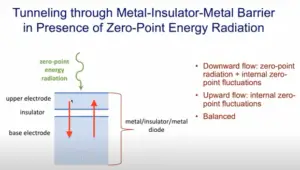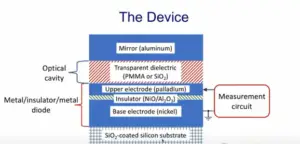Here is a video of a presentation by Garret Moddel of the University of Colorado at Boulder. He was speaking at an online conference hosted by The UnLAB held Jan 18-22, 2022. The full meeting and talks can be accessed here:
https://unlab.us/advanced-propulsion-and-energy-2022/
Some of the key points and quotes from the video:
He asks how much energy is available from the zero point energy field, and based on theoretical calculations based on Planck’s constant he says that the current which is available from the photon flux of the background electromagnetic field is 1.7 GA (giga amps) per square meter.
Two major problems when it comes to extracting this energy:
1. This background energy is the universal ground state: “We can’t induce a flow by having a change in its density because it’s the same everywhere”.
2. The fluctuations in this ZPE are field are very short-lived.
He asks: Can we modify the ground state? And he answers, yes we can – with the Casimir cavity.
He also says that energy may be ‘borrowed’ from the vacuum.
Here’s a slide showing the basic setup of his device:

“The basic device consists of a metal insulator, a metal structure . . . The upper insulator is semi-transparent, there is a very thin insulator which allows electrons to tunnel or hop over the barrier, and the base metal is a little thicker.
“So if we imagine this thing just sitting in equilibrium, in steady-state, we’ve got ZPE modes in the base metal, these are dominantly in visible light, and energy, these are dominantly in the form of plasmons, and so these plasmons will have a distribution, there’ll be fluctuations that can create a sufficiently hot electron to go across the barrier to the top metal.
“Similarly, in the top metal there are going to be these plasmons powered by ZPE that will create electrons that can go in the opposite direction, but this top metal is a little bit thinner, so there are fewer of those electrons. On the other hand, there are also the external vacuum enery modes which can energize an electron by the photo-electric effect. That hot electron might be able to traverse this thin metal, go across the insulator and get to the bottom metal. In this way, if we’re sitting in equilibrium, there’s no net flow.
“Now let’s put a Casimir cavity on top, the Casimir cavity blocks the low frequency modes. We’re now going to have fewer electromagnetic modes from the ZP field, so we’ve now broken the balance, we now have net electron flow from the bottom to the top.”
The Device:

“We are actually producing power in our devices, and the power is substantial. The maximum measured power density is 70 W/m2”
He notes that these are very small devices.
The full video can be seen here:

